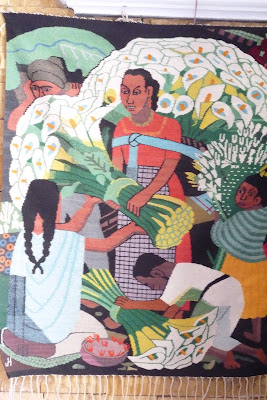The Weaver's Studio we visited was really interesting and I have gone through that group of fotos; so here goes -
Avenida Juarez #100
Teotitla del Valle CP70420
Oaxaca, Mexico
tel fax 01 95-24-40-72
no website currently available
They are using the old traditional elements in the creation of the dyes for their wool; bugs, minerals, plants, etc. The demonstration on the dye colors was really interesting - first crush some bugs, OK very specific bugs and get one color - then add lime juice for another color, then a mineral pigment for a different, then baking soda for something else.












In weaving, weft or woof is the yarn which is drawn under and over parallel warp yarns to create a fabric. In North America, it is sometimes referred to as the "fill" or the "filling yarn", and in India, it is referred to as "baana". " Baana" word has been derived from another hindi word "bun na" or "bunai" which means making with threads or strings, as done in cane weaving and other forms of primitive weaving techniques.
The weft is a thread or yarn of spun fibre. The original fibre was wool, flax or cotton. Nowadays, many synthetic fibers are used in weaving. Because the weft does not have to be stretched in the way that the warp is, it can generally be less strong.
The weft is threaded through the warp using a shuttle. Hand looms were the original weaver's tool, with the shuttle being threaded through alternately raised warps by hand. Inventions during the 18th century spurred the Industrial Revolution, and the hand loom became the more robust spinning frame with the flying shuttle speeding up production of cloth, and then the water frame using water power to automate the weaving process. The power loom followed in the 19th century, when steam power was harnessed.





